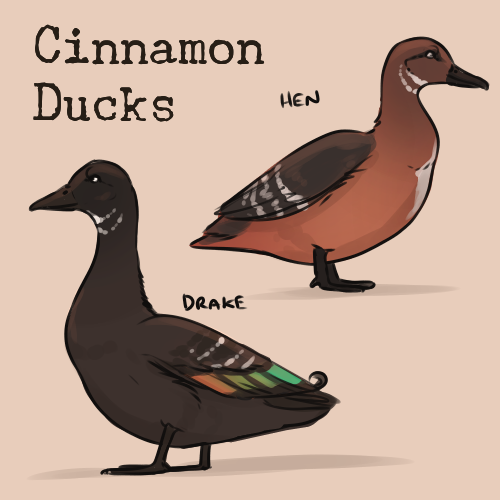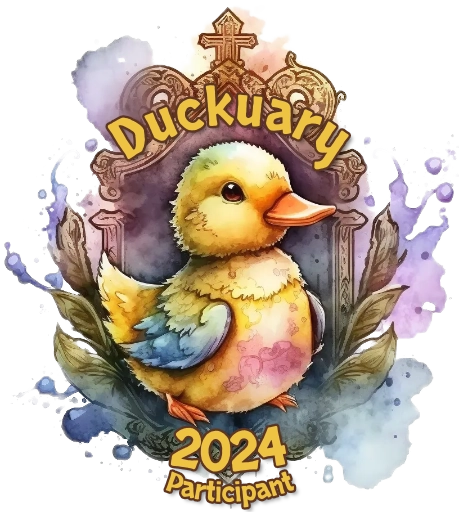The cinnamon duck is a widespread, large duck species found across temperate regions of the known world. Intelligent and incredibly social, cinnamon ducks are a favourite in many cultures and are often seen as a symbol of family or community. Once so common as to be considered a pest, cinnamon ducks are facing a rapid decline in numbers. Also known as "copper ducks", their striking colouration and generous size make them popular hunting targets.
Description
Cinnamon ducks are a large duck species. Around 65-70cm in length, and weighing in around 2-2.5kg, they compare in size to quite a few domestic duck species. This heaviness would usually lead to a clumsy bird with little flight potential, but they make up for their bulk with particularly long, strong wings, with wingspans around 100cm.
Cinnamon ducks are named for their female colouration- females are easily recognised by their bright, cinnamon-red plumage. Females have a dark head and back, black feet and bill, and bright white or grey eyes. Their feathers are accented with silvery pumage in lacing patterns on the chin and wings, and a large white patch on the front.
Males are less common, and could easily be mistaken for another species. Very dark in colour, their deep brown, glossy plumage can be mistaken as almost entirely black in low light. The speculum feathers of the male are incredibly striking, possessing an iridescent copper and green colour-shifting colouration.
Distribution and Habitat:
Cinnamon ducks are widespread across Aresia, Katka, Mirron and Osmen. Despite this large and varied range, they are no longer particularly common in any one place. Strongly migratory, they tend to spend their summers grazing thawed land opportunities in Virias, Northen Sedia, Mirron and Katka before spending harsh winters in the warmer South Sedia and Osmen. Rarely, they winter in Skypirros, but this is very uncommon today. It is thought that the ducks more frequently used to winter in the isles in the past; as evidenced by old Skypirrossan recipes featuring the ducks and use of feathers in old crafts.
Fairly adaptable, the ducks are found in both fresh and brackish waterways, and seem to be able to tolerate saltwater and oceanic dabbling for short periods when food is limited. They favour temperate environments, and don't cope well in sub-freezing temperatures. They do quite well in warm environments, so long as water is plentiful. They are known to take advantage of urban environments where they can, with some of the most stable populations of cinnamon ducks being those that have learned to frequent parks and ponds where people congregate.
Diet
Cinnamon ducks, like most ducks, are omnivorous. Very flexible in its feeding arrangements, their hardy stomachs allow them to digest almost any organic material effectively. Despite this, around 50% of their usual diet is usually made up of grass, 40% insects or gastropods, and the remaining 10% being other incidental materials. During summer, cinnamon ducks can often be seen taking advantage of krill and shrimp blooms along coasts, though this is a very seasonal affair and ingesting high levels of salt for too long has a negative effect on the ducks' health.
Social Habits and Breeding
Cinnamon ducks are incredibly social animals, and move together in large flocks. The flocks can be anywhere from a handful of individuals to hundreds of birds. Social interaction is very important to the ducks, and grooming and bonding between flock members seems to be a mandatory daily behaviour. In winter, this behaviour benefits them as they are able to group together to keep warm in formations known as "puddles". The large group of ducks rotates around in a spiral, giving all the individuals a chance to warm up in the centre of the puddle and keep the group at a safe average temperature.
Cinnamon ducks are a ground-nesting species. They form pairs in their wintering grounds, and begin nesting in spring. Clutches of eggs range from four to as many as twelve, and will be incubated for around a month. Unlike most ducks, cinnamon ducks are quite dedicated mates, and while they are not strictly monogamous, many mating pairs have been observed rejoining and mating for many years in a row. The social structure around raising young is quite diverse, and seems to foster a "flock-first" mindset which ensures the survival of as many ducklings in the flock as possible. Most pairs consist of a male and female who are the biological parents of the ducklings, though same-sex pairs have been observed adopting orphaned eggs and ducklings, as well as pairs in which another male or female pairs up with a duck who already has offspring but has lost a mate, and takes over the missing role. Older, infertile females are often seen "babysitting" eggs or large creches of ducklings for the younger hens in a flock, allowing tired parents to spend some time feeding or bonding.
Predators, Threats and Conservation
Cinnamon ducks are an attractive meal to both animals and people alike- they are very heavy bird, and carry a large amount of fat on their keel leading up to winter, making them a target of foxes, wolves, cats, raccoons, bears and other animals preparing for winter. People are not an exception; cinnamon ducks have been heavily hunted throughout the Second Age. Often hunted with firearms and bows, they are often seen as a perfect "first hunt" for parents to teach their children with, and their attractive plumage and generous size make them a perfect hunting lodge decoration.
Cinnamon duck numbers have dramatically decreased in the last century. Where flocks with upwards of 200 birds were common in the past, many hunters call a flock "large" when it has anything over 30 individuals. Their unique social structure and high duckling survival rate seems to have helped keep them from extinction in the past, experts insist protections need to be in place to ensure the birds aren't wiped out in the next 50 or so years.
In Virias, new laws were implemented in 10,955 SA to enforce a strict window in which the birds are allowed to be hunted, and are protected by law outside of that window. The window is for 2 weeks only, shortly before the birds fly south to Sedia for the winter, and the laws also limit the number of birds an individual hunter can take, and outlaws shooting birds that are not moulted into their adult plumage.
In the city of Astrellos, Sedia, cinnamon ducks are protected by law in parks and gardens throughout the city. These laws were established in 11,640 SA by then Queen Aspenella for her daughter, Lady Luella. The famously spoiled young princess was infatuated with cinnamon ducks, and demanded that her parents protect them by law after seeing children chasing them with sticks on an outing to the Top Plate Gardens. There are incredibly harsh jail sentences to anyone who deliberately chases, harms or injures a cinnamon duck or their nests, and unfortunately, this law seems to mostly affect the poor of the lower city who occasionally try to catch the ducks from parks for food.
Katkan people eagerly await the nesting season of the ducks, where collecting down from the nests is a family tradition that has been upheld for countless years. It is thought that removing too much of the down from the nests may reduce hatching rates of the eggs, but the Katkan people insist their traditional harvesting method is careful and deliberate, and that the amount of down taken from each nest is safe for the birds.

by spooktacular
Schollarly name: Annial cyannicus
Common Name: Cinnamon duck, puddle duck, copper duck
Conservation: Threatened
Range: Widespread across temperate regions

Badge by Tillerz using MJ






Comments